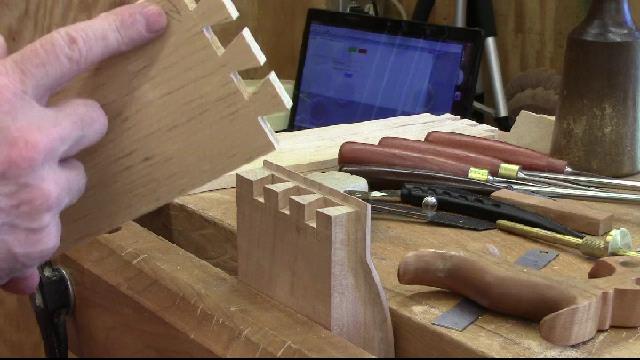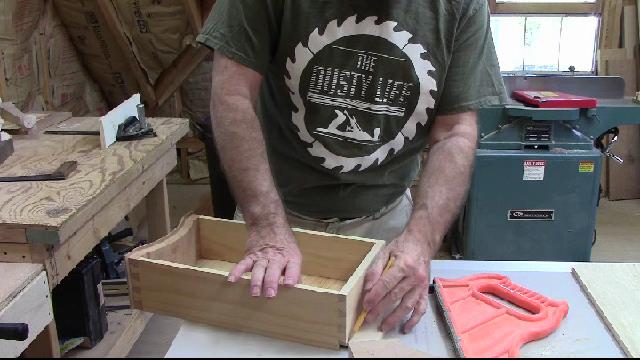I have an 8/4 board that is 11 1/2 inches wide, if I resaw and glue it up it will be wide enough.
I need to use my large bandsaw for this task, it has 12 inch clearance under the blade guides. I milled 2 sides and 1 edge flat before resawing. This way I would have one side flat on each board after resaw. I made sure that my fence was perpendicular to the saw table as well as the blade. I have a 3/4 inch blade on the saw.
The resaw came out just fine with nearly 1 inch on both boards. I match the grain the way I want. I milled the boards to 7/8 and then joint the edges and glue up the panel. After the glue up I flattened and sanded the panel to 13/16.
I use my crosscut sled on the table saw to square up the top. The top just fits in my crosscut sled which is 22 inches wide.
I use a left over drawer blade as a template for the curves on the front of the lowboy top. I just traced a pencil line for the cut out.
I used a jig or sabre saw to cut out the pattern. The cut needs to be cleaned up with a spokeshave, files and sand paper before I put the edge on the top.
I get that in the next post and video.
Meanwhile, I decided to work on mounting the hardware on the drawer fronts.
I am using classic brass hardware from Ball & Ball Hardware. The backplate is nice and flat but we need it curved to fit the drawer fronts. In addition, it has to be curved in two different directions, concave and convex.
I have a wooden form with a smaller radius than the drawer fronts. I can strap the brass to the form and when it is removed it springs back slightly.
I use strap clamps to bend and hold the backplate to the form. I use a deadblow hammer to help the brass to fit the wooden form.
The bent backplate fits on the drawer front well. Now I have to bend the bail to fit the curve and drill the holes for the posts at a 15 degree angle. I got the angle from my old video when I made this lowboy before.
I use the same technique for bending the bail, I use the strap clamp of hold it in place and then hit it with the deadblow hammer of bend it to the form.
I used my drill press with a jig set to 15 degrees, just a piece of scrap wood screwed to the face of a box on the drill press.
This allows me to rest the drawer on the jig at the correct angle for drilling. I decided to drill a practice drawer front first.
Drilling the practice drawer front.
The holes worked out very well, the posts are at the correct angle and the bale fits right in the posts. So we are good to go with the drawers.
Bending a bail for the drawer front.
Looks good, the concave drawer fronts were completed by bending the backplate in the opposite direction on the same form. I did change the angle of the drill jig to the opposite direction to drill the holes for the posts.
The next steps will be to put the edge on the top and carved the corners. That will be in the next post and video.

















































